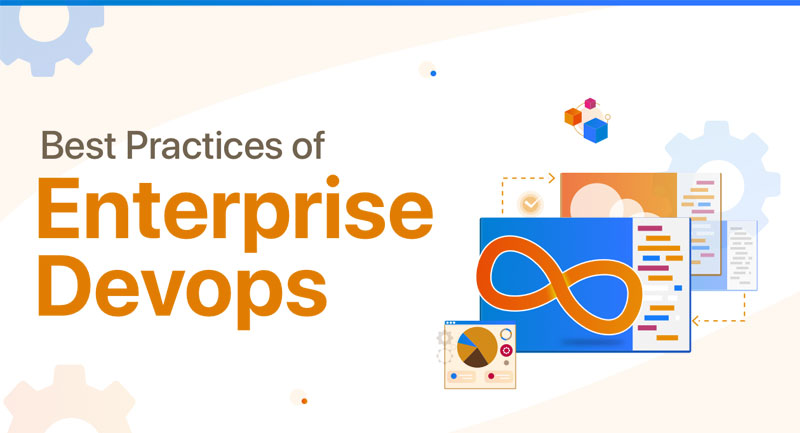“DevOps is the union of people, process, and product to enable continuous delivery of value to end-users.” – Donovan Brown
DevOps has garnered the attention of the IT industry for all the right reasons. By integrating the development & operations teams, DevOps have accelerated software development and deployment while enhancing customer satisfaction.
Undoubtedly, DevOps has transformed the IT industry’s operations while bringing all the teams under one roof.
The global DevOps market is expected to grow from $7.20 billion in 2021 to $8.95 billion in 2022 at a compound annual growth rate (CAGR) of 24.24%.
Because each organization’s journey and path are distinct, DevOps transformation help achieve goals that are constructed across your organization’s culture. But how can we do that? Let’s move forward and see what the top 8 enterprise DevOps transformation practices are;
What are the top 8 Enterprise DevOps Transformation Practices?

Here are the top eight strategies for successful DevOps transformation;
1. Test automation maintains the flow of the software lifecycle
To deliver quality code; software developers need to test the software regularly. In the Software Development Lifecycle (SDLC), automated testing helps execute code faster than manual testing.
Test automation can be achieved easily by identifying the test case scenarios, deploying the right tools, and setting up the right tools while analyzing the results. The benefit of using automated testing can be applied to the networking & database, the configuration of the middlewares & development of source code.
Some test automation tools that you must know of are;
- Selenium
- UFT (Unified functional testing)
2. Crucial configuration management
Change management and configuration, as we know, are two basic frameworks for operations. Through configuration management, the improvement teams get a larger picture of the entire scenario. Integrated configuration management allows the teams to utilize the existing offering rather than investing timeand effort in doing that from ground zero.
Tools used for configuration management are-
- Chef
- Ansible
3. High-quality performance solutions with continuous integration
Continous integration in DevOps allows the developers to implement the integrations faster. Through this practice the development team can frequently update the code within the repository for automatic builds and test runs.
Continuous Integration allows the tools to identify the situation integration and alter them at a sooner phase. CI is an agile development practice that is generally linked with DevOps, and allows the developers to take regular steps by enhancing a continuous feedback loop.
Some tools that are used in continuous integration are;
- GitLab
- Jenkins
4. Improvement in QA coordination
Test automation helps in reducing test cycles & improving the quality of the test coverage. Although automating all the processes is not essential, but just to stay on the safer side, you need to determine the required iteration.
The main objective of DevOps tech to deliver the code faster to the product. Through continuous improvement and monitoring of four key metrics- lead time, Mean time to repaid, failure rate and deployment frequency, the delivery performance can be improved drastically.
Some of the common tools used in monitoring are:
- Datadog
- Splunk
5. Establish short-term objectives
Starting your transformation with simpler initiatives allows you to make it easy to implement the projects can be deployed quickly and at a faster pace.With agile applications, DevOps is a better option as it helps you reach wider audience. Created with an agile & lean approach they support DevOps. Don’t plan more than three months ahead of time for the best results.
One of the greatest advantages of adopting this approach is to maintain long-term flexibility and consistency in your DevOps journey planning.
Some of the common tools used for the same are;
- AWS CodeDeploy
- Octopus Deploy
- Jenkins
- TeamCity
6. Focus on a continuous feedback mechanism
Many enterprises these days struggle to provide software that helps elevate their customer satisfaction levels. But can an organization know if the software is in line with the customer expectations or not? Feedback loops can help simplify the communication that happens between the tests and spot problems.
You can easily enable a continuous feedback mechanism with DevOps while enhancing internal team collaboration.
7. Monitoring software to optimize the application performance
This parameter is necessary when deploying the performance on the cloud. A bug that hits an application during the release phase becomes a failure.
Several tools are available for monitoring the application providing several metrics related to application, support, sales, and graphs.
Operating systems, CPUs, memory usage and I/O services generally provide monitoring abilities that can be handled by monitoring the tools. Each individual in the team should be well aware of the operational necessity and also use the right tools to visualize it to the users.
Some tools that are beneficial for application monitoring are;
- Datadog
- Monitis
8. Production support is mandatory
At the enterprise level, many teams are on the latest versions or releases with added features presented during the production process. Development teams are on the third level of production support because they help fix production issues. The development teams must work on new releases to increase efficiency and mark serious production obstacles.
A benefit of production support is that it allows developers to understand its works and reinvent their solutions accordingly.
Closing Words
Although DevOps implementation and adoption seem simple, it is simpler said than done!
Scaling DevOps at scale is a real challenge for many organizations, and one crucial aspect of the same is that many businesses misinterpret that the DevOps journey is more technical.
Organizations need to understand that the DevOps journey covers many processes and platforms, selecting which can be difficult, and this is where Netsmartz’s DevOps transformation services prove beneficial.

Summary
Kickstart Your Project With Us!
Blog
Popular Posts
CONTACT US
Let's Build Your Agile Team.
Experience Netsmartz for 40 hours - No Cost, No Obligation.
Connect With Us Today!
Please fill out the form or send us an email to
 Don't Miss Out:
Don't Miss Out: 







